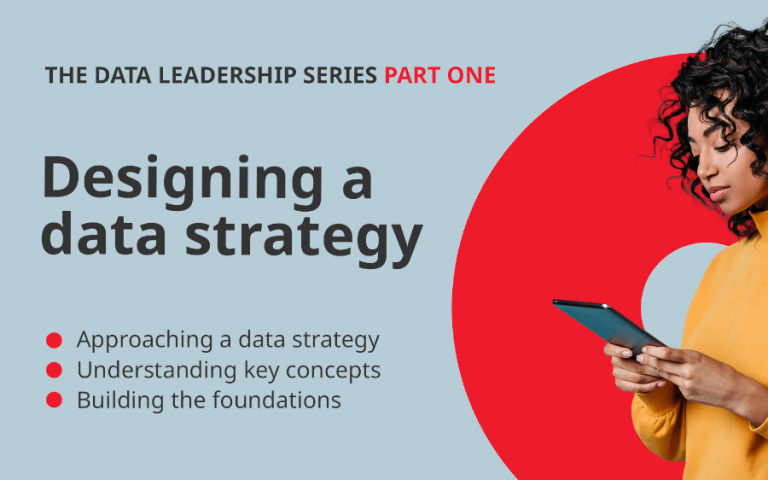In the previous article, ‘Designing A Data Strategy’, we discussed the approach, core concepts and foundations. This article focuses on how to make your data strategy investable.
Introduction
A data strategy is a plan. As Simon Sinek rightly pointed out, Martin Luther King didn’t begin his famous speech with “I have a plan.” You need a vision, an outcome in mind, that provides the North Star for your data strategy. A data leader with a strong WHY inspires others – which makes change management significantly easier when making difficult decisions. The core narrative of your data strategy must be compelling and capable of being retold well.
- Link your data strategy goals to the goals of the business
- Acknowledge what has worked and not worked in the past
- Paint a future picture and make it personal – how will your business life be better
- Write an accessible document: business led, not technical
- Get away from your desk and learn from leaders and practitioners
RECOMMENDATION
Create different versions of your strategy for various audiences (i.e. a detailed plan in a document, a presentation you can use to tell the strategy story to different groups, and a simple walk-around version for one-on-one conversations). The strategy should be one of your best Data Management marketing tools.
Binding your data strategy to business objectives - it increases the likelihood of investment
When you define your goals, they should be informed by your organisation’s strategy. The goals are often ill-defined, unmeasurable, and based on unvalidated assumptions. If, for example, an organisation’s strategic objective is to ‘improve the speed and quality of decision-making,’ and your data strategy goals align with this objective, then the investment case will be decided on two factors: will the value [of improved decision-making] exceed the cost of delivery and is this plan [the strategy that will improve decision-making] credible?
RECOMMENDATION
You never want to find yourself working on data that is not of the highest importance to the business. When business objectives shift, you must shift your strategy.
Be investment sleuths at the strategy stage
An unfunded data strategy is a dead strategy. By understanding the criteria for reaching funding decisions, you can influence them in your favour. Find the investment criteria of the individuals you seek to influence and deliver a plan that matches that criterion. If your CFO views the Internal Rate of Return as a more credible metric than ROI, do the maths that way. If your CMO is struggling with the rising costs of paid media and is fed up with death-by-dashboard, show up and listen. If your CEO is hung up on selling the revolutionary power of generative AI to the Board, start to align the narrative of your data strategy accordingly.
RECOMMENDATION
Chase the money. Where the business is spending money is where they find the greatest value. What data is needed to achieve that value?
Create an investable data strategy - not a compendium of best practices
What is the key differentiator between an investable data strategy and a long document that goes in the never-drawer? One is a business document that presents outcomes, value and how you will manage change; the other is a technical document that speaks about data standards, risk management and a veritable cornucopia of inaccessible technical jargon. You should reference a series of technical documents relating to data governance, data quality, how data will be managed, and the technical details behind the plan, but do not lead with them – they are components of the delivery plan, not the essence of the strategy.
RECOMMENDATION
Write your Executive Summary last, and then write it again. A coherent narrative, strong evidence and a focus on outcomes create a more accessible document.
Reigniting a classic with a modern twist: Data Management by wandering around…
Toyota called it the “Gemba walk,” but the origins of MBWA can be traced back to HP executives in the 70s (or the mid-late 20th century, according to Gen Z data scientists). The idea was that wandering around allowed for random sampling of events instead of waiting for planned reports that could be months away. Taking the initiative to do the Data Gemba Walk – an unplanned tour of other teams’ work and events in the organisation – and listening acutely to how they interact with data will deliver an entirely new perspective that will help you contextualise the work needed to deliver uplift with your data strategy.
RECOMMENDATION
Hold structured and unstructured stakeholder interviews to obtain as broad and representative a sample as possible to validate your strategy assumptions.
Next steps
Interested in learning more? Download the EDM Council Data ROI Report on Data as an Asset for a deeper dive into formally calculating data value and return on investment in data.
contentS
- Introduction
- Bind your strategy to business objectives
- Be investment sleuths
- Create an investable data strategy
- Reigniting a classic with a modern twist
- Next steps
Webinar
We discussed this topic – and much more! – with our amazing guest speakers in the 1st online event of our Data Leadership Series. Catch up now!


